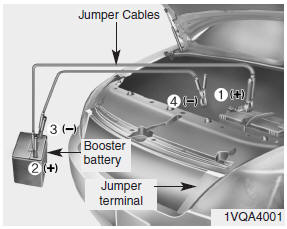 Hyundai Veloster: Emergency starting
Hyundai Veloster 2011-2017 Owner's Manual / What to do in an emergency / Emergency starting
Hyundai Veloster: Emergency starting
Hyundai Veloster 2011-2017 Owner's Manual / What to do in an emergency / Emergency starting

Connect cables in numerical order and disconnect in reverse order.
Jump starting
Jump starting can be dangerous if done incorrectly. Therefore, to avoid harm to yourself or damage to your vehicle or battery, follow the jump starting procedures. If in doubt, we strongly recommend that you have a competent technician or towing service jump start your vehicle.
CAUTION
Use only a 12-volt jumper system. You can damage a 12-volt starting motor, ignition system, and other electrical parts beyond repair by use of a 24-volt power supply (either two 12-volt batteries in series or a 24-volt motor generator set).
WARNING - Battery
Never attempt to check the electrolyte level of the battery as this may cause the battery to rupture or explode causing serious injury.
WARNING - Battery
- • Keep all flames or sparks away from the battery. The battery produces
hydrogen gas which may explode if exposed to flame or sparks.
If these instructions are not followed exactly, serious personal injury and damage to the vehicle may occur! If you are not sure how to follow this procedure, seek qualified assistance. Automobile batteries contain sulfuric acid. This is poisonous and highly corrosive. When jump starting, wear protective glasses and be careful not to get acid on yourself, your clothing or on the car. - • Do not attempt to jump start the vehicle if the discharged battery is frozen or if the electrolyte level is low; the battery may rupture or explode.
Jump starting procedure
1. Make sure the booster battery is 12- volt and that its negative terminal is
grounded.
2. If the booster battery is in another vehicle, do not allow the vehicles
to touch.
3. Turn off all unnecessary electrical loads.
4. Connect the jumper
cables in the exact sequence shown in the illustration. First connect one end of
a jumper cable to the positive terminal of the discharged battery (1), then connect
the other end to the positive terminal on the booster battery (2). Proceed to connect
one end of the other jumper cable to the negative terminal of the booster battery
(3), then the other end to a solid, stationary, metallic point (for example, the
engine lifting bracket) away from the battery (4). Do not connect it to or near
any part that moves when the engine is cranked.
Do not allow the jumper cables to contact anything except the correct battery terminals or the correct ground. Do not lean over the battery when making connections.
CAUTION - Battery cables
Do not connect the jumper cable from the negative terminal of the booster battery to the negative terminal of the discharged battery. This can cause the discharged battery to overheat and crack, releasing battery acid.
5. Start the engine of the vehicle with the booster battery and let it run at 2,000 rpm, then start the engine of the vehicle with the discharged battery.
If the cause of your battery discharging is not apparent, you should have your vehicle checked by an authorized HYUNDAI dealer.
Push-starting
Your manual transaxle-equipped vehicle should not be push-started because it might damage the emission control system.
Vehicles equipped with automatic transaxle cannot be push-started. Follow the directions in this section for jump-starting.
WARNING
Never tow a vehicle to start it because the sudden surge forward when the engine starts could cause a collision with the tow vehicle.
 If the engine will not start
If the engine will not start
If engine doesn't turn over or turns over slowly
1. If your vehicle has an automatic transaxle, be sure the shift lever is in
N (Neutral) or P (Park) and the emergency brake is set. 2. Check th ...
 If the engine overheats
If the engine overheats
If your temperature gauge indicates overheating, you experience a loss of power,
or hear loud pinging or knocking, the engine is probably too hot. If this happens,
you should:
1. Pull off the roa ...
See also:
Air cleaner
Filter replacement
It must be replaced when necessary, and should not be cleaned and reused.
You can clean the filter when inspecting the air cleaner element.
Clean the filter by using compressed ...
Emergency Towing
There are three popular methods of towing a vehicle :
-
The operator loads the vehicle on the back of truck. This is best
way of transporting the vehicle.
...
Dimensions
...
Categories
- Hyundai Veloster Manuals Home
- Hyundai Veloster 2010-2017 Owner's Manual
- Hyundai Veloster 2010-2017 Service Manual
